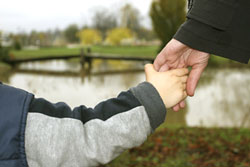Family Therapy Effective in Treating Childhood Anxiety
 The Tarnow Center believes strongly in treating not just individual children, but the entire family system. Although a child may exhibit symptoms ety, depression, behavioral pr other psychological symptoms, ily is a unit, and each person family affects the others and learn to interact in a different in order for the symptomatic begin to feel better and to become symptomatic.
The Tarnow Center believes strongly in treating not just individual children, but the entire family system. Although a child may exhibit symptoms ety, depression, behavioral pr other psychological symptoms, ily is a unit, and each person family affects the others and learn to interact in a different in order for the symptomatic begin to feel better and to become symptomatic.
This approach is suppor recent study documenting the ness of family cognitive behavioral apy for children and adolescents clinical anxiety disorders. The conducted by Susan M. Bogels, and Lynne Siqueland, Ph.D., and published in the February, 2006 issue of the Journal of the American Academy of Child and Adolescent Psychiatry.
Anxiety is a family affair
Anxiety disorders run in families. It is generally believed that there is an overlap of up to 80% between parental and child anxiety disorders. This is a result of both genetic factors and the parenting style of anxious parents. Parents who are themselves anxious are often over-protective or controlling, rather than encouraging their children's autonomy. Anxious parents are also more prone to be critical or rejecting rather than warm or accepting. Such parental behavior maintains childhood anxiety.
It's not simply that anxious parents choose these parenting styles, it is sometimes the case that anxious children provoke these parenting styles. For example, dependent children evoke controlling parenting. In this way, both child and parental anxiety contribute to parental overprotection and criticism.
The authors of this study investigated whether altering parenting style, through cognitive behavioral therapy, would, in turn, resolve anxiety disorders in children. They found that, to a great degree, the therapy was successful for both parents and children alike. This proved to be true not only during the study period, but even more so over time. Their twelve month follow up showed that families continued to improve. The therapy empowered and educated parents to facilitate changes in their anxious child. Their success is in contrast to providing the anxious child with individual cognitive behavioral therapy, which has proven ineffective with 20-50% of children.
Most therapy time spent with parents
During this study most of the treatment time was spent with parents, and made use of a "transfer of control" model. The effort was to modify the parents dysfunctional beliefs because it is these beliefs that prevent anxious children from improving. The author's intent was to decrease child anxiety, decrease child dysfunctional thinking, decrease parental anxiety, decrease parental dysfunctional beliefs, decrease anxiety enhancing parenting and improve family functioning.
The individual family therapy was conducted in three phases. In phase one, (consisting of two sessions with parents and child together, one with the child alone and one with the parents alone), the family was taught to challenge negative beliefs and the parents were encouraged to use their new skills to guide their anxious child and to cope with their own fears. They were taught to do "courageous modeling." In phase two of the study (consisting of three sessions with the parents alone and one with the child alone), the therapist worked to modify dysfunctional beliefs between parents and child that could block the process of change. These sessions focused on parental beliefs about their anxious child, parenting and the safety of their child's world. In the session with the child alone, the therapist worked to modify the child's dysfunctional beliefs about communication with their parents.
Phase three of the study, focused on communication and problem solving between the spouses about their child's anxiety (in one session with the parents), and between all family members including siblings (in two sessions with the whole family). In the last session (with parents and child), treatment was evaluated and relapse prevention was rehearsed.
One of the most striking findings of this study was the delayed impact and durability of improvement. Immediately after treatment no significant improvement on parental psychopathology and dysfunctional thinking was observed. However, at follow up, both parents reported improvement on internalizing symptoms and mothers reported improvement on externalizing symptoms. The dysfunctional thinking of both parents concerning their child's anxiety and their role as parents was reduced at time of follow up.
Consistent with treatment goals both parents reported less overprotective rearing and fathers reported less rejection. A decrease in these attitudes may have been a result in the reduction of parental anxiety. Parental anxiety makes parents more irritable and changes in parental rearing result from decreases in child anxiety. Parents respond to their child's chronic anxiety with anxiety, rejection and control.
Children reported improvement in family relationships. It was speculated by the authors that the improvement in these family relationship reflected changes in parental rearing behaviors.
This study implied that, first, fathers can and should be included in treatment. Second, family cognitive behavioral therapy appeared to be a good alternative for child cognitive behavioral therapy. Third, the further improvement of families after treatment supported the author's clinical impressions that ending family treatment, even after a limited number of sessions, is important, even if there is little immediate improvement. During the study, the greatest improvement was observed in the months after therapy ended as the new family dynamic took hold.